How to renovate your turf surfaces following the hot summer
Related Articles
If 2018 has taught those who work outdoors anything, it is to expect the unexpected!
At the time of writing we have had a year with more snow, more rain and more blistering sunshine in one year than many can ever recall … so what is in store for us in the autumn?
Predicting the weather often makes a fool of us all. Will the weather become stormy, and wet because the sea is very hot and that means energy will be transferred in evaporation to clouds, followed by rain? Or, as current forecasts suggest, we are in an extended period of warm settled weather? Across the nation of course, it could be a mixture of both!
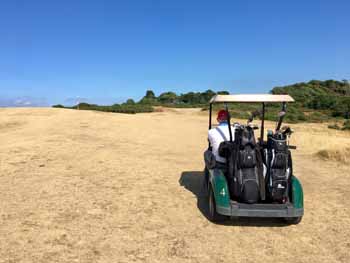
A drought affected fairway on a golf course in Wales
Trying to translate how this will affect turf management issues is where the greenkeeper’s skill and knowledge is most needed. The summer has had a hugely stressful impact on the grass. Firstly, there is the obvious problem of outright death. It is expected in annual species like poa annua but it is also likely there will be significant death of perennial plants that have been on ‘the edge’ of their survival limits or ‘zone of tolerance’ by conditions this year.
Secondly, there will be plants that struggle through to autumn in a weakened condition. Their weakness may be due to a number of factors such as:
- Water stress – they haven’t grown as well or matured fully.
- Heat stress – photorespiration may lead to reduced root mass.
- UV light stress.
- Insufficient fertiliser inputs (because it’s been too dry to fertilise without water availability) or irrigation may have leached much of it away.
- Summer disease attack – physical damage to the plant.
- Accumulation of salts and ions such as calcium, iron, sodium and so on deposited by irrigation water during the summer months. As water evaporates, these elements left behind as deposits causes shifts in soil pH (alkalinity or acidity), which causes changes in microbial populations as their zones of tolerance are affected.
- Build-up of organic debris (from plant death, leaf shedding and root residues) above and below the surface.
The problem for greenkeepers is that the odds are already stacked against them. There is a combination of direct damage to the plant by disease and stresses plus the problem of an environmental shift in the plant growing environment; coupled with the imbalances of microbial populations.
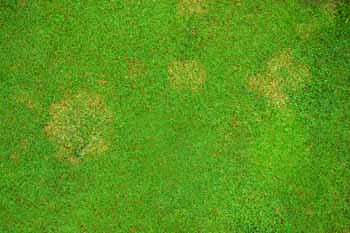
Turf diseases unless treated at their early stages can be devastating on weakened turf
How this is translated into disease risk, when looking at the typical diseases of late summer and autumn, needs to consider the following:
- Reduced nutrient inputs – will favour red thread, fusarium, anthracnose (blight and basal rot), rusts and leaf spot.
- Organic matter, surface build-up harbour decomposers that can become pathogens (killers) if optimum circumstances provide them with super growing conditions (humid, mild, little air movement and so on).
- Organic matter on the surface will also tend to hold moisture and this will encourage attack from basal rot anthracnose, dollar spot, fusarium and so on, by providing moisture for the fungi to grow and set and transport spores during reproduction.
- Organic matter build up (soil) – increased risk of superficial fairy rings, thatch fungus, various fairy rings and possibly unusual diseases such as brown patch and so on.
Plant stress – every plant has an immune system just like our own and if it is weak it has less of immunity to invading disease. Photorespiration will have deprived the plant of carbohydrate energy resources to draw on when under attack and therefore its response will be weaker.
The major concern is that due to such unfavourable growing conditions, the turf faces not just one or two concerns but will be hit by a barrage of problems occurring all at once and the threat is from multiple pathogens for multiple reasons … so what is required?
Advanced planning!
- Plant first aid – the first thing to do is provide first aid for the plants that have survived the stresses of summer to strengthen them. The plant will benefit from nutrition from fertilisers to rebuild tissue, but other materials such as Amino-Form LX containing amino acids will enhance this process.
- Soil first aid – soils will need reconditioning which may require:
- Wetting agent – to aid water penetration, infiltration (soil re-wetting) on areas such as fairways, greens surrounds, approaches, carries and so on.
- Aeration – to aid water penetration – even if this is only 12 to 25mm deep penetration at first. It is important to capture water and help it into the soil as on hard baked surfaces the water just runs off.
- Surface organic matter (fibre) – this needs raking out to avoid its hydrophobic properties preventing water entering the soil or, once it eventually hydrates, acting like a sponge over the autumn / winter. Do this before seeding!
- Soil conditioners – both plant and soil have had a battering in the hot conditions so application of products to help the soil recover and, more importantly, soil microbial communities to recover, are appropriate. Consider the use of humic acids to aid soil conditioning, soil structuring products (Integrate) and so on.
- Install new plants – where plants are dead no amount of TLC is going to bring them back so overseeding will be a priority! Without overseeding, expect a huge increase in annual meadow grass in the sward. The new tetraploid perennial ryegrass blends such as R26 CRT or R6 CRT are an excellent choice as they have exceptional tolerance and recovery from environmental stress as well as show excellent disease tolerance.
- Plant protection – have a strategy for plant protection before the problems arise. Even with all the best cultural practices in place, disease and pests still occur when conditions are right, though hopefully with good cultural practice the impact will be less severe.
Of course, when it comes to planning, emergency or otherwise, the biggest difference greenkeepers will face this autumn, when deciding their late summer / autumn fungicide programmes, will be the products that are available to them compared to last year.
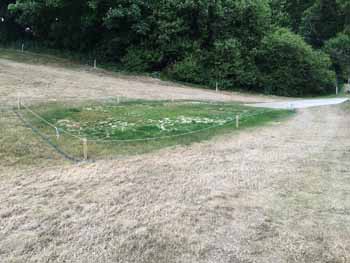
“R6 CRT is phenomenal in drought conditions, thriving where others would diminish. Very pleased how it responded with very little water and preparation.” Scott Gibson, course manager, St Enodoc GC
The loss of Iprodione based products takes away ‘the get out of jail’ card that many have relied upon in the past. Unfortunately, the replacement products do not have the ability to eradicate established disease and therefore need to be used as preventative sprays.
All fungicide applications need to be flexible to cope with prevailing weather conditions, disease pressure and be integrated with the club’s nutritional, biological and cultural programmes.
Prevent and protect
Following the reseeding or renovation programme, there will be a need to protect the existing plants and newly germinating seedlings from a range of stress and disease pressures. One ideal treatment following such programmes is the Rigby Taylor Exteris Renovation Package. This tank mix programme contains Bayer’s latest SDHI chemistry featuring the active ingredients fluopyram (SDHI) and trifloxystrobin (strobilurin), combined with the recovery agents Trimate (fulvic and amino acid) and Option; a new adjuvant containing phosphite to stimulate root development and the plants own defence mechanism.
Exteris, is ideally suited for use at this time of year as the active fluopyram is one of the few products taken up by both the foliage and root system so it can protect the whole plant. The Stressguard part of the Exteris formulation also contains a UV filter to reduce damage caused by high solar radiation, together with a dew dispersal system to reduce retention of moisture on the foliage.
The basis of a preventative programme is always to minimise disease levels and not allow the fungi levels to increase. To achieve this, it is necessary to plan an approach using the range of active ingredients available with the first round of the treatments being applied during mid August to mid September, depending upon disease conditions.
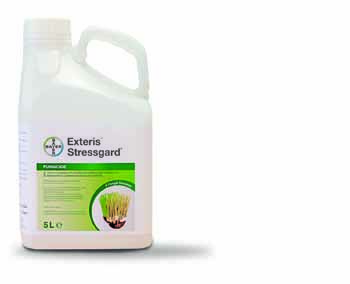
Exteris fungicide is one of the few products taken up by both the foliage and root system so it can protect the whole plant
The most prevalent and damaging disease likely to occur in the autumn is microdochium nivale – commonly called ‘Fuzz’ – and it requires more than five consecutive days of suitable conditions for it.
Rigby Taylor has nine tank mix programme options that cover all the likely disease conditions affecting turf throughout the year; some are specific such as the Renovation programme and another for fairy rings, whilst others contain actives and mixture partners that synergise to enhance performance and target a broad spectrum of diseases, all however are designed to meet both a club’s technical and budgetary requirements.
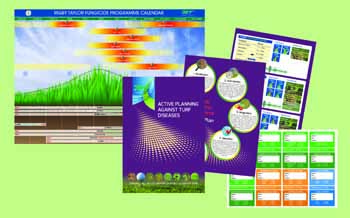
Disease management and fungicide chart for proactive planning
A fungicide programme planning chart and 12-page brochure is being made available to greenkeepers to allow them to pre-plan and record their fungicide and disease management activity throughout the year.
Compiled with contributions from Peter Corbett and Noel Mackenzie, Rigby Taylor Ltd

























